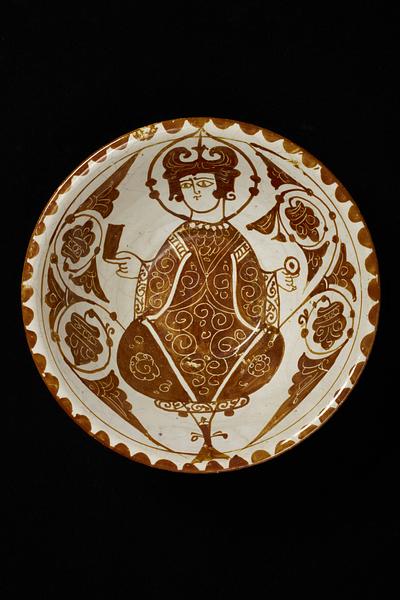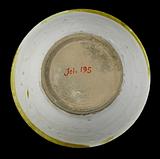Like its Fatimid, Egyptian models, Syrian Tell Minis pottery was experimental. It comprised tin-glazed earthenware, fritware with an opaque, white glaze, and fritware under a clear glaze that let the ware’s pale-pink color shine through.
The frontally positioned Mediterranean figure and splendid palmettes also point the way to Fatimid lustreware. The clothing and headgear do not tell us clearly whether this is a young man or a woman, and neither can we readily identify the objects – a beaker and a fruit? – in his or her hands.
Inv. no. Isl 195
Published in:
Ernst J. Grube: The classical style in Islamic painting: the early school of Herat and its impact on Islamic painting of the later 15th, the 16th and 17th centuries: some examples in American collections, [Venice] 1968, fig. 4, p. 13;
C .L. Davids Samling. Fjerde Del : Jubilæumsskrift 1945-70, København 1970, cat.no. 3, p. 272;
Richard Ettinghausen: “Further comments on Mamluk playing cards” in Ursula E. McCrecken, Lilian M. C. Randall, Richard H. Randall (eds.): Gatherings in honor of Dorothy E. Miner, Baltimore 1974, fig. 34;
André Leth: Davids Samling. Islamisk kunst = The David Collection. Islamic Art, København 1975, p. 30;
Art from the World of Islam. 8th-18th century, Louisiana, Humlebæk 1987, cat.no. 53;
Venetia Porter and Oliver Watson: "”Tell Minis" wares” in Oxford studies in Islamic art, 4, 1987, p. 207, cat.no. A3 and p. 221;
Kjeld von Folsach: Islamic art. The David Collection, Copenhagen 1990, cat.no. 87;
Kjeld von Folsach and Anne-Marie Keblow Bernsted: Woven Treasures: Textiles from the World of Islam, The David Collection, Copenhagen 1993, fig. 3, p. 40;
Kjeld von Folsach, Torben Lundbæk and Peder Mortensen (eds.): Sultan, Shah and Great Mughal: the history and culture of the Islamic world, The National Museum, Copenhagen 1996, cat.no. 121;
Markus Hattstein and Peter Delius (eds.): Islam: art and architecture, Berlin 2000, p. 197;
Kjeld von Folsach: Art from the World of Islam in The David Collection, Copenhagen 2001, cat.no. 135;
Alfried Wieczorek, Mamoun Fansa, Harald Meller (eds.): Saladin und die Kreuzfahrer, Landesmuseum für Vorgeschichte, Halle, Mainz 2005, cat.no. B. 8, pp. 324-325;
Almut v. Gladiss (ed.): Die Dschazira: Kulturlandschaft zwischen Euphrat und Tigris, Museum für Islamische Kunst, Berlin 2006, cat.no. 9, p. 50;
Ahmet Cayci: Selcuklularda egemenlik sembolleri, Istanbul 2008, fig. 27, p. 99;
Jonathan M. Bloom and Sheila S. Blair (eds.): The Grove encyclopedia of Islamic art and architecture, New York 2009, vol. 1, p. 455;
Kjeld von Folsach, Joachim Meyer: The Human Figure in Islamic Art – Holy Men, Princes, and Commoners, The David Collection, Copenhagen 2017, cat.no. 9;



